Two identical small charged spheres play a fundamental role in understanding the behavior of charged particles and the nature of electric interactions. Coulomb’s Law, a cornerstone of electrostatics, governs the force between these spheres, providing a mathematical framework for quantifying their interactions.
This article delves into the intricacies of this law, exploring its implications for understanding the behavior of charged particles and the broader field of electromagnetism.
Beyond Coulomb’s Law, we will investigate the superposition principle, a powerful tool for analyzing the combined effects of multiple charged spheres. We will also explore the concepts of electric field and electric potential, providing a comprehensive understanding of the electrostatic interactions between these spheres.
Coulomb’s Law
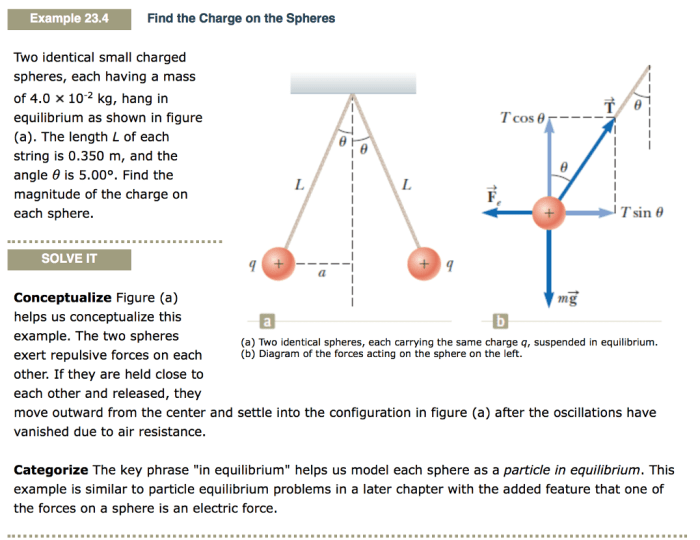
Coulomb’s Law is a fundamental law in physics that describes the electrostatic force between two point charges.
The force between two point charges is directly proportional to the product of the charges and inversely proportional to the square of the distance between them.
Mathematical Formula, Two identical small charged spheres
The mathematical formula for Coulomb’s Law is:
F = k
- (q1
- q2) / r^2
where:
- F is the electrostatic force between the charges
- k is Coulomb’s constant, which is approximately 8.98755 × 10^9 N m^2/C^2
- q1 and q2 are the charges of the two particles
- r is the distance between the two particles
Significance
Coulomb’s Law is a significant law in understanding the behavior of charged particles. It helps us understand the forces that act between charged objects and how these forces affect the motion of these objects.
Electric Force between Two Identical Small Charged Spheres
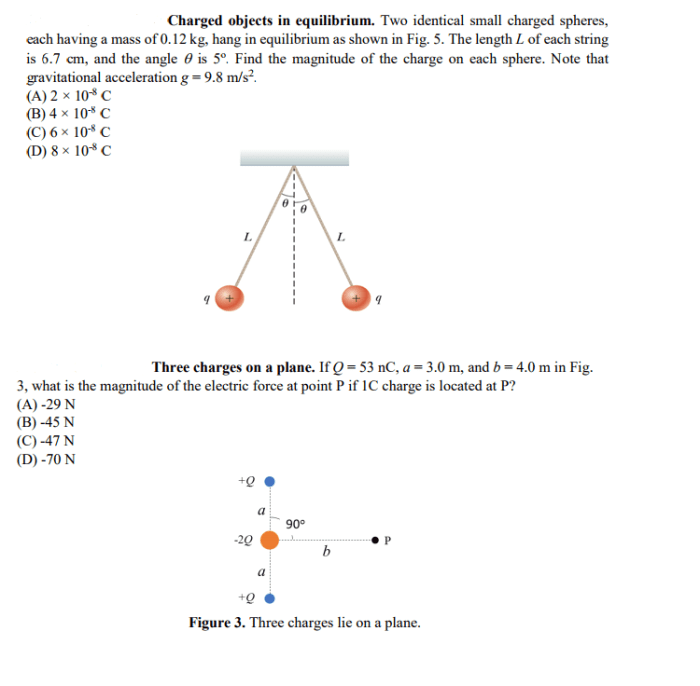
The electric force between two identical small charged spheres is a fundamental concept in electromagnetism. This force arises due to the electrostatic interaction between the charges on the spheres and plays a crucial role in various physical phenomena.
Calculating the Electric Force
The electric force between two point charges is given by Coulomb’s Law:
F = k
- q₁
- q₂ / r²
where:
- F is the electric force (in Newtons)
- k is Coulomb’s constant (8.988 × 10⁹ N m²/C²)
- q₁ and q₂ are the charges on the spheres (in Coulombs)
- r is the distance between the centers of the spheres (in meters)
For two identical small charged spheres with the same charge q, the electric force becomes:
F = k
q² / r²
Superposition Principle
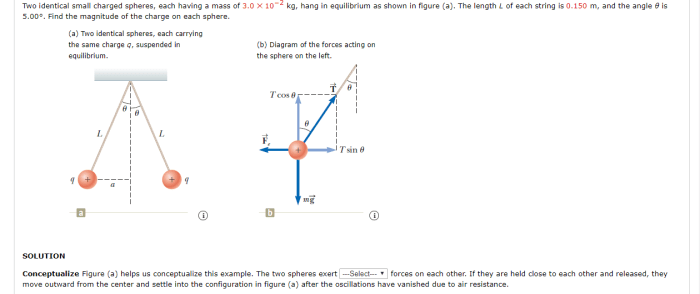
The superposition principle states that the electric force between two charged particles is the vector sum of the electric forces that each particle would exert on the other if the other particle were alone.
In other words, the electric force between two charged particles is not affected by the presence of other charged particles.
Using the Superposition Principle
The superposition principle can be used to calculate the electric force between multiple charged spheres.
To do this, we first calculate the electric force between each pair of spheres.
Then, we add up the electric forces to get the total electric force.
Examples of the Superposition Principle in Action
The superposition principle is used in many applications, including:
- Calculating the electric field around a charged object
- Designing electrical circuits
- Understanding the behavior of plasmas
Electric Field
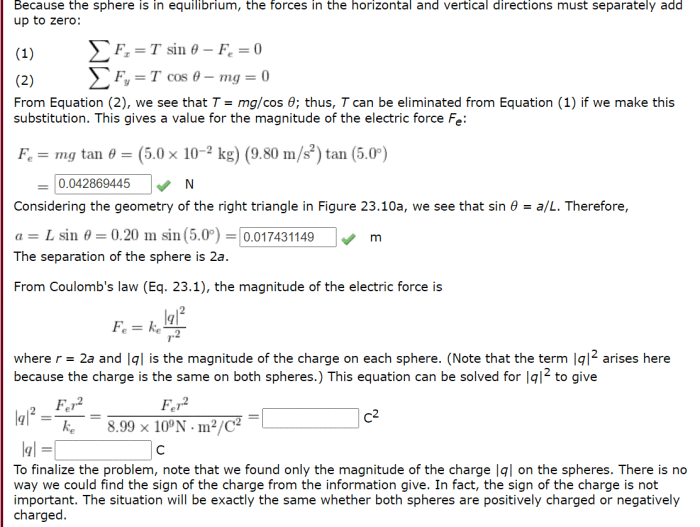
The electric field is a region of space around a charged object in which other charged objects experience an electric force. It is a vector quantity, meaning it has both magnitude and direction. The magnitude of the electric field is equal to the electric force per unit charge.
Calculating the Electric Field Due to a Single Charged Sphere
The electric field due to a single charged sphere can be calculated using the following formula:
E = k
q / r^2
where:
- E is the electric field strength in newtons per coulomb (N/C)
- k is Coulomb’s constant, which is approximately 8.988 × 10^9 N⋅m^2/C^2
- q is the charge of the sphere in coulombs (C)
- r is the distance from the center of the sphere to the point where the electric field is being calculated in meters (m)
Relationship between Electric Field and Electric Force
The electric field is directly related to the electric force. The electric force on a charged particle is equal to the product of the particle’s charge and the electric field strength. In other words:
F = q
E
where:
- F is the electric force in newtons (N)
- q is the charge of the particle in coulombs (C)
- E is the electric field strength in newtons per coulomb (N/C)
Electric Potential
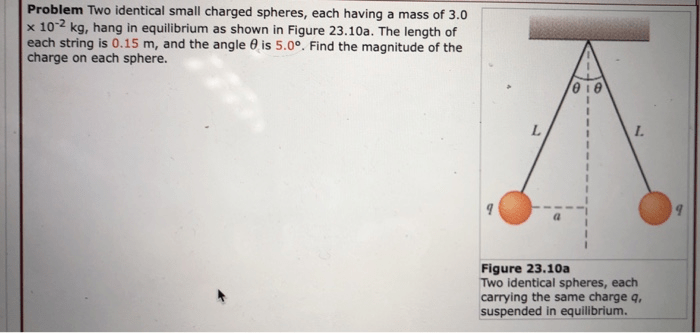
The electric potential at a point in space is defined as the amount of electrical potential energy per unit charge at that point. It is a scalar quantity and is measured in volts (V).
The electric potential due to a single charged sphere can be calculated using the following formula:
$$V = k\fracqr$$
where:
- Vis the electric potential (in volts)
- kis Coulomb’s constant (8.98755 × 10 9N⋅m 2/C 2)
- qis the charge on the sphere (in coulombs)
- ris the distance from the center of the sphere to the point where the potential is being calculated (in meters)
The electric potential is related to the electric field by the following equation:
$$E =
\nabla V$$
where:
- Eis the electric field (in volts per meter)
- ∇ is the gradient operator
- Vis the electric potential (in volts)
Top FAQs
What is Coulomb’s Law?
Coulomb’s Law describes the electrostatic force between two point charges. It states that the force is directly proportional to the product of the charges and inversely proportional to the square of the distance between them.
What is the superposition principle?
The superposition principle states that the net electric force on a charged particle due to multiple other charged particles is the vector sum of the individual forces due to each particle.
What is the electric field?
The electric field is a vector field that describes the strength and direction of the electric force at a given point in space. It is defined as the force per unit charge at that point.
What is the electric potential?
The electric potential is a scalar field that describes the amount of electrical potential energy per unit charge at a given point in space. It is defined as the work done per unit charge to bring a positive charge from infinity to that point.